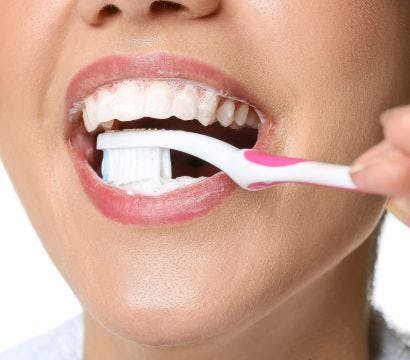Having healthy teeth is more than flashing a set of bright pearly whites. Your gums, tongue, and breath can offer valuable clues to your oral well-being. In this article, discover how to keep your teeth in the best possible condition and the telltale signs of healthy teeth.
12 ways to keep your teeth healthy
Maintaining your dental hygiene may seem like a drag but stick with it and the entire process will become automatic. Plus, it’s worth it. Think of all the benefits proper oral care brings – a bright smile, minty-fresh breath, and improved confidence. Sounds great, right? Build a routine with the 12 tips below.
1. Brush your teeth thoroughly.
You know that you’re supposed to brush your teeth at least twice daily. But it’s not as much about the frequency as it is about the quality. You can brush four times but if you’re not doing it properly, all that effort is for nothing.
Brush carefully to avoid scratching your enamel. Hit even the hard-to-reach areas, like the sides of your molars and the backs of your teeth. Mastering proper brushing techniques can help you avoid cavities and gum disease.
2. Find the right toothbrushing tools.
Not all toothpaste and toothbrushes are created equal. Unless your dentist recommends otherwise, find a toothbrush with soft bristles. Read the differences between manual and electronic toothbrushes to see which would work best for you.
Your toothpaste should have fluoride. Whether your goals are to whiten your smile or to combat tooth sensitivity, cavity-fighting fluoride should be your dental care holy grail.
3. Floss daily.
Consider flossing as an essential not an extra step in your routine. It removes food particles and other grime between your teeth, allowing you to brush better and prevent bacteria from accumulating.
4. Use extra dental hygiene tools.
If you’re feeling a little extra, you can invest in other oral hygiene tools beyond your toothbrush and floss. Use mouthwash, a tongue scraper, or a water flosser. If you have crooked teeth, you might want to consider braces or dental aligners like ClearCorrect to make dental care easier.
5. Visit your dentist.
Don’t ignore those twice-a-year checkups. A professional cleaning can remove any plaque or tartar buildup you may have missed. It also allows your dentist to check for potential tooth decay and address it accordingly.
6. Drink lots of water.
You may not always have time to brush your teeth after every meal. Drinking water is the next best thing. H2O rinses out lingering food particles and bacteria. It also hydrates your mouth, preventing bad breath.
7. Avoid cavity-causing foods.
Sugar and acids like orange juice or coffee can wreak havoc on your teeth. Sweet foods are a fast pass to cavity-causing bacteria. Acids, on the other hand, can hasten the breakdown of your enamel. Lemon slices are hard to resist so drink some water or brush your teeth after a piece.
8. Eat a balanced diet.
Did you know that the right food can help you maintain healthy teeth? Treat your pearly whites to soy, cheese, fruits and vegetables, and green tea. These have substances that combat decay and strengthen teeth. Crunchy fruits and vegetables like apples and celery also help clean your teeth naturally.
9. Don’t use your teeth as tools.
How many times have you attempted to open a bag of chips or pulled the string from a gift with your teeth? Heaven forbid you use your chompers to open some XXXX! Treating your teeth as scissors or a bottle opener can cause chips or cracks.
10. Wear a mouthguard.
Don’t forget to don a mouthguard when playing sports or partaking in strenuous physical activities. If you have bruxism (teeth grinding), contact a specialist to see if you should wear a mouthguard at night.
11. Get adequate sleep.
The connection between teeth and sleep isn’t obvious, but oral hygiene is a holistic practice. Sleep helps restore and renew your immune system, which extends to your mouth! Enough rest ensures your body is strong enough to fight infections from bacteria overgrowth in your mouth.
12. Chew on some sugar-free gum.
Another way to keep your mouth hydrated is to chew gum – sugar-free, of course. It triggers saliva production, which can neutralise acids and wash off food particles.
Why you should check for healthy teeth signs

Did you know that oral health is the gateway to your overall health? According to the peer-reviewed journal Medicina, “Scientific research in the medical field shows this constantly: health starts from the mouth.”
The literature has also demonstrated possible implications of poor oral health, including complications in the cardiovascular and nervous systems. Proper hygiene could prevent pathologies and “have great systemic implications… for society and for the quality of life in individuals.”
How long can teeth stay healthy? As long as you want to reduce the risk of diseases, maintain good oral health, and promote overall well-being! Maintaining healthy teeth offers the following perks:
- Prevents tooth decay and gum disease.
- Allows you to enjoy your favourite foods and beverages without discomfort.
- Helps avoid costly dental treatments in the future.
- Improves your smile.
- Boosts your confidence in social situations.
7 signs your teeth are healthy

Remember a winning smile doesn’t necessarily mean your teeth are the picture of health. Watch for these signs to ensure your teeth are always in good shape.
1. Similar-coloured teeth
Contrary to popular belief, yellow teeth do not always equate to unhealthy teeth. The off-white tinge may be their natural shade – genetically determined by your dentin and the thickness of the enamel.
However, yellow teeth can also be problematic because discolouration can arise from plaque buildup.
Another cause for concern is if you notice a miscoloured tooth standing out from the set. The staining or darkening may be due to dental decay, an injury, a dead nerve, or an infection. In such cases, you should see your dentist instead of opting for at-home whitening remedies.
2. Firm, pink gums
“Gums should be a healthy pink, and should be solid when touched,” says The Canadian Academy of Dental Health and Community Sciences (CADH). They should keep your teeth in place and build a barrier against bacteria. Healthy gums should not bleed, recede, turn red or white, or feel tender.
If you notice any of these symptoms, you might be brushing too aggressively and putting pressure on the area. Or you could already be damaging your enamel and developing some form of disease.
3. Moist, pink tongue
Your tongue also offers valuable insights into your dental situation. Like your gums, it should be firm and pink. A white coating or any form of discolouration can indicate underlying oral issues. Adding to this, the muscle should be moist – a sign that saliva effectively flushes out food particles from your teeth.
4. Strong teeth
Loose teeth are a source of excitement for kids. Who doesn’t love a visit from the tooth fairy? But for adults, shaky permanent teeth can be worrisome. They point to gum disease, injury, plaque, stress, grinding, and overall poor oral hygiene. If you can wiggle a tooth easily, schedule a dentist appointment immediately. The same goes if you notice loose crowns or fillings.
5. Pleasant breath

A mouth with healthy teeth should have a neutral smell. According to an Oral Diseases journal article, coated tongue, gum disease, and poor oral hygiene are the predominant causes of halitosis. Bad breath also suggests the presence of bacteria or decaying food particles and untreated tooth decay.
To know your breath situation, cup your hands over your mouth and nose and breathe out. Alternatively, you can smell your dental floss after cleaning. If you don’t notice any unpleasant odour, then you’re all clear.
6. No tooth sensitivity
Do you experience tooth discomfort when consuming hot or cold food and beverages? You may be dealing with dentin hypersensitivity (DH), which the Journal of Dentistry defines as “pain derived from exposed dentin in response to chemical, thermal tactile, or osmotic stimuli.”
Research studies have found significant connections between DH and erosive tooth wear and gum recession. Aggressive brushing and an acidic diet are also potential factors contributing to this condition.
7. Aligned teeth
The CADH adds, “teeth that are overly crowded or too spaced out can cause bacteria to build as they can be harder to clean, and can lead to unnecessary wear and tear on the teeth.” Misaligned teeth also cause mouth breathing, jaw problems, gum disease, and tooth decay. Plus, they can affect the way you eat and speak.
To address these issues, orthodontists recommend aligners, like ClearCorrect, that improve dental hygiene and facilitate tooth preservation. According to a GMS Hygiene and Infection Control study, these transparent and removable dental appliances “facilitate oral hygiene and have been shown to significantly improve periodontal health indices.”
Aligners also have the advantage of segmented tooth movement and shortened treatment time versus traditional braces.
ClearCorrect offers more than other leading aligner brands. It combines a proprietary tri-layer ClearQuartz material with a flat and unscalloped performance trimline and scientifically proven ClearControl to help your teeth get that picture-perfect straightness.
These tips can help you maintain your healthy teeth. If you have any issues, remember that only your dentist can provide a definitive conclusion. Certain factors, like cavities and abscesses, remain invisible to the naked (and untrained!) eye. So, take a proactive stance on your dental health and schedule a checkup today.
References:
Addy, M. (2005). Tooth brushing, tooth wear and dentine hypersensitivity — are they associated? International Dental Journal, 55, 261–267.
Aylikci, B. U., & Çolak, H. (2013). Halitosis: From diagnosis to management. Journal of Natural Science, Biology, and Medicine, 4(1), 14.
Davari, A. (2013, September 1). Dentin Hypersensitivity: Etiology, Diagnosis and Treatment; A Literature Review. PubMed Central (PMC).
Europe PMC. (n.d.). Europe PMC.
Fiorillo, L. (2019). Oral Health: The First Step to Well-Being. Medicina-lithuania, 55(10), 676.
Hemadmin. (2021). 5 Signs That Teeth Are Healthy and Strong for Students in Dental Hygienist School. CADH.
Khalid, A., & Quiñonez, C. (2015). Straight, white teeth as a social prerogative. Sociology of Health and Illness, 37(5), 782–796.
Kramer, A., & Splieth, C. (2022). Health promotion through structured oral hygiene and good tooth alignment. DOAJ (DOAJ: Directory of Open Access Journals), 17, Doc08.
Memon, M. A., Memon, H. A., Faizan-E-Muhammad, Fahad, S., Siddiqui, A. R., Lee, K. Y., Tahir, M., & Yousaf, Z. (2022). The aetiology and associations of halitosis: a systematic review. Oral Diseases.
Vieira, A. R., Gibson, C. W., Deeley, K., Xue, H., & Li, Y. (2015). Weaker Dental Enamel Explains Dental Decay. PLOS ONE, 10(4), e0124236.
Watts, A., & Addy, M. (2001). Tooth discolouration and staining: a review of the literature. British Dental Journal, 190(6), 309–316.
West, N. X., Sanz, M., Lussi, A., Bartlett, D. L., Bouchard, P., & Bourgeois, D. (2013). Prevalence of dentine hypersensitivity and study of associated factors: A European population-based cross-sectional study. Journal of Dentistry, 41(10), 841–851.



